 By Pepper Parr By Pepper Parr
August 23, 2019
BURLINGTON, ON
Ooops!
A portion of a sentence was left off the paragraph about the pipeline that runs through the centre of the city that was mentioned in the story on the Construction Management procedures that will be in place for the building of the condominium opposite city hall.
In explaining the traffic congestion that was going to take place in the downtown core at the same time two high rise condominiums were to be built we left out the detail about remediation work being done to the pipeline that runs through the city – it carries fuel for aircraft at the Hamilton airport. No specific date on when that work will start.
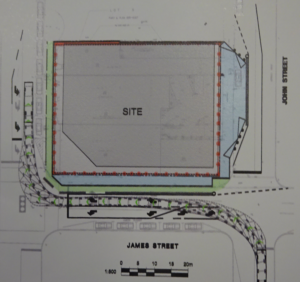 Transit traffic will come down Brant and swing onto James and then go south on John. 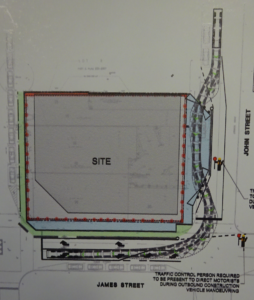 Cement and dump trucks will come south on John street, drive on to the site and then continue down John to Brant when they have off loaded The public was told that Lakeshore Road will close for a period of time while repair work on the surface is done.
Detail on what the flow of traffic would be during the 30 month construction period that The Gallery, the 23 story condominium that will be built opposite city hall, was released.
Cement trucks and dump trucks will compete with buses and private automobile for room on Brant, John and James Street.
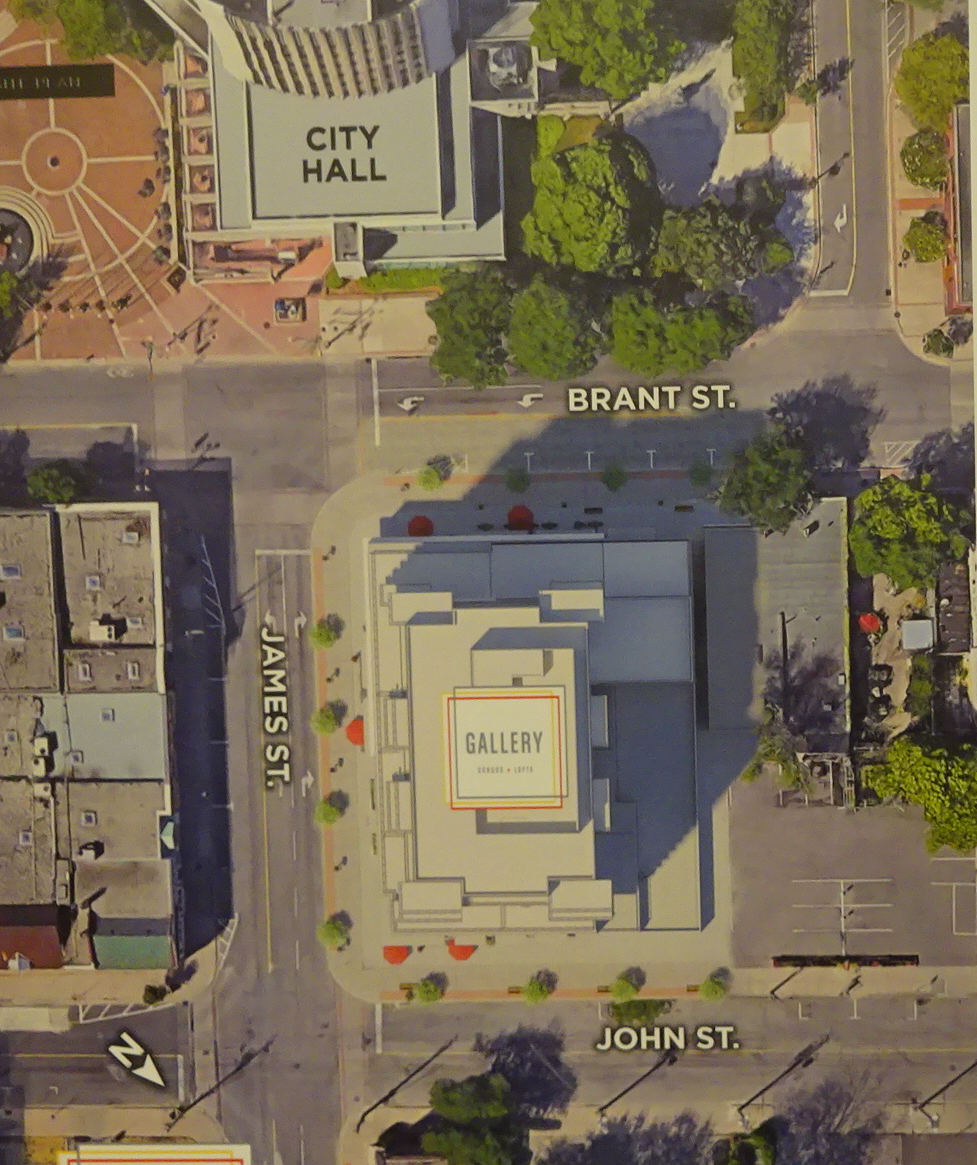 An aerial rendering of how the condominium will fit into the corner of Brant and James – with city hall across the street. It will be interesting to see how the Santa Claus parade winds its way through that part of the city in December.

 By Staff By Staff
August 23, 2019
BURLINGTON, ON
Homicide detectives with the Halton Regional Police Service have laid charges in relation to a homicide that took place in Burlington on August 21, 2019.
Kenneth SOEDERHUYSEN (57) of Burlington is charged with First Degree Murder.
SOEDERHUYSEN appeared in Milton court yesterday.
The victim has been identified as Laura GRANT (57) of Burlington.
The accused and the victim were married at the time of the incident, and both resided at 2244 No. 2 Side Road where the incident took place.
The police are encouraging anyone with additional information regarding this incident and/or investigation to call the Halton Regional Police Service Homicide Tip Line at 905-825-4776.
Tips can also be submitted to Crime Stoppers “See something? Hear something? Know something? Contact Crime Stoppers” at 1-800-222-8477 (TIPS) or through the web at www.haltoncrimestoppers.ca.
Related news story.
Police investigating a homicide on #2 SideRoad

 By Pepper Parr By Pepper Parr
August t 22nd, 2019
BURLINGTON, ON
 Lisa Kearns waiting for a question from the audience. Lisa Kearns, Councillor for ward 2 was back before her constituents again – it was the second week in a row that she stood before an audience and took them through the intricacies of Construction Management and Traffic control during construction projects..
Last week the meeting was related to the Adi Nautique development at the corner of Lakeshore and Marsha where the audience learned that the construction timeline is about 30 months.
This time it was the Carnacelli development opposite city hall – where the time line is 30 months. The 23 storey development, known commercially as The Gallery also has a new address – because the entrance is going to be on James they are using the municipal address of 2011 James to identify the development – not to confuse people who follow this type of thing.
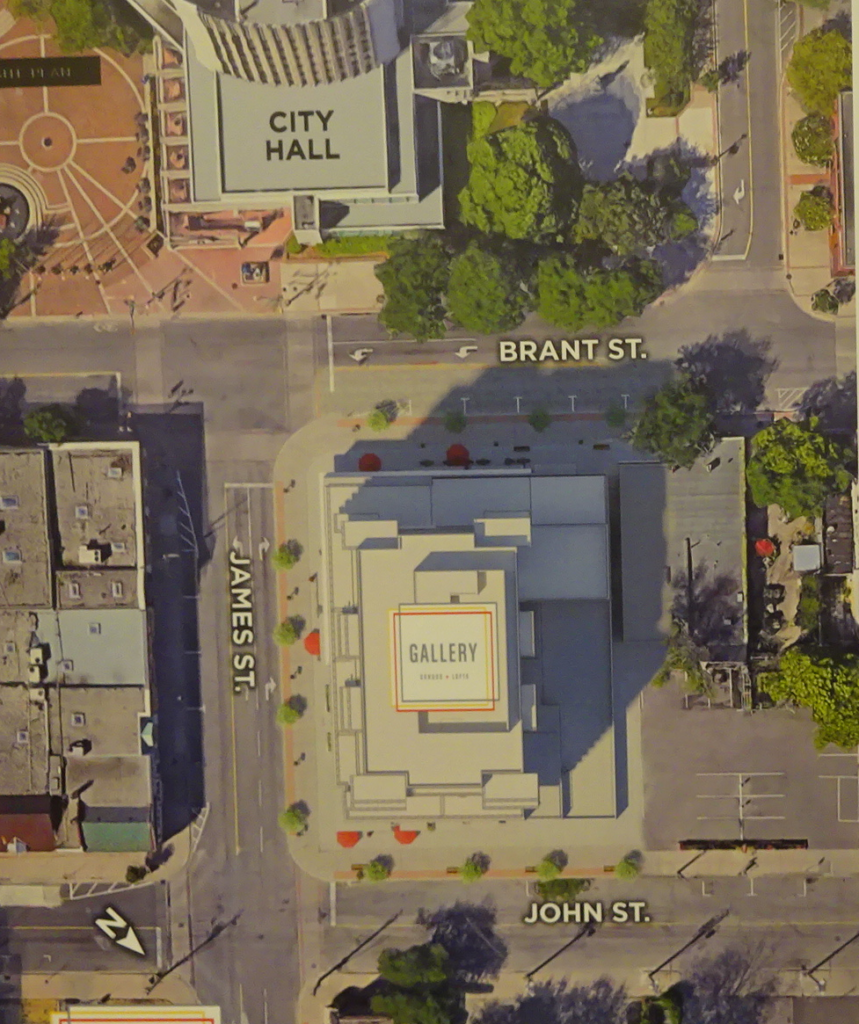 The property to the left of the site has been approved for 17 storeys – they have appealed asking for 23 stories to match The Gallery development. The Centro Garden is on the extreme right. The two developments are less than a km apart and will be under construction at about the same time.
Carriage Gate, the developers of the project, announced that they expect to begin demolition sometime immediately after Labour Day.
At about the same tine Lakeshore Road will be closed for a period of between eight and twelve weeks for road improvement work.
The audience was also advised that a pipeline that runs right through the city coming in from the Beachway along Elgin Street and running through the rear of the Mayrose Tayco property at the north end of the Elizabeth Street parking lot is scheduled to have some major remediation done – no specific dates were given.
Chaos is the word that best describes what is going to take place in the city.
The objective is to manage that chaos as professionally as possible. Kearns was in the room explain that everything was going to be fine – there were protocols and procedures in place to handle every situation.
Drawings were displayed showing where the trucks that will haul away the material from the demolished site and where the concrete trucks would be staged while they were waiting to enter the site, disgorge the concrete and move on so that the next truck could come in.
 Cement and dump truck movement plan.  Transit movement plan. The public will not lose the use of the Brant Street or James Street – the areas where construction is taking place will be covered so that pedestrians are safe.
Kearns assured the audience that she would be on top of it all – her office on the eighth floor of city hall overlooks the site.
Concern about the noise, the dust and the traffic flow were not as important as to where the trades people working on the site were going to park. The Carnacelli interests on the property the Berkeley was built on and the land to the north where there was to be a parking lot and a medical building that would front on Caroline – that space will be used for parking in the early stages. Mark Bales who is overseeing the project did announce that the corporation had arranged to rent about 40 parking spots from the city – which didn’t go down all that well with the area residents or those with retail operations in the immediate area.
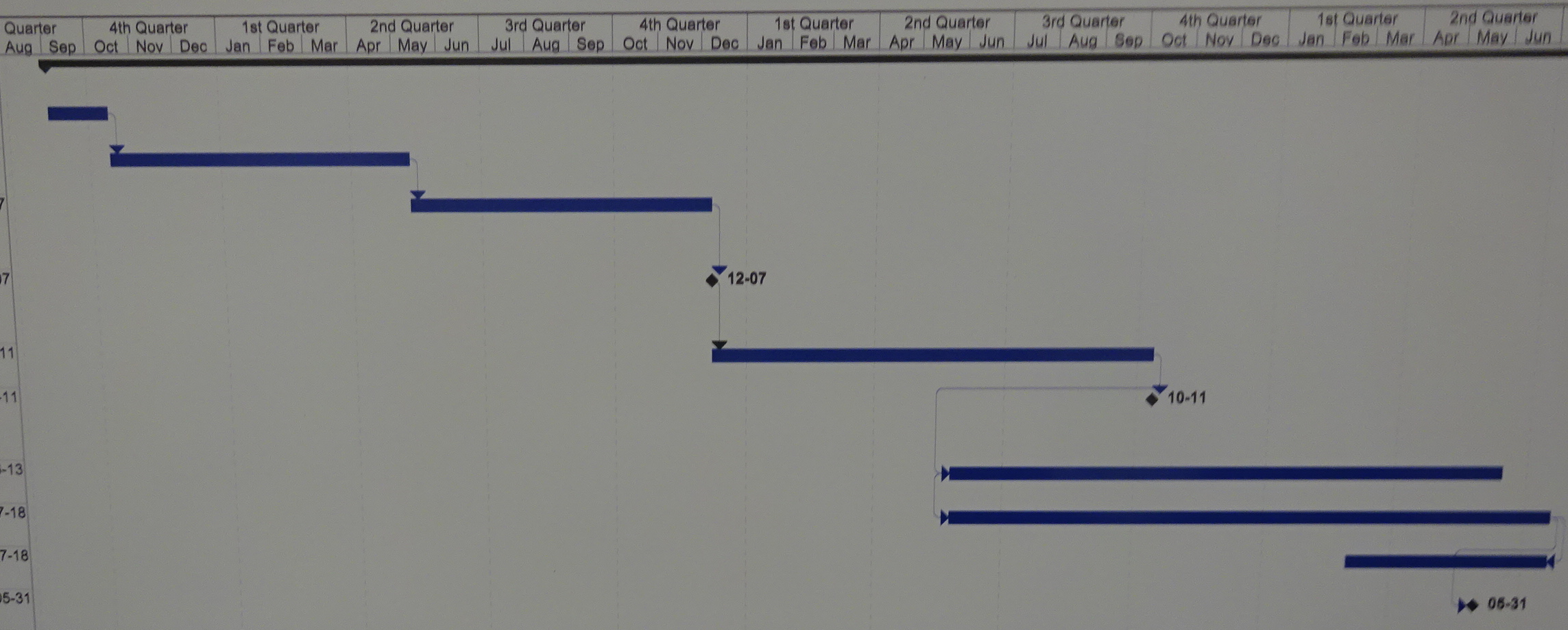 Timeline for the construction and completion of The Gallery opposite city hall. People wanted to know how many trucks would be in the area – they were told seven to nine which was later bumped up to 12. They will be driving in and out of the site from 7:00 am to 7:00 pm.
The audience was told that there could be anywhere between seven and seventy workers on the site at any one time.
Kearns has worked with Transportation department people and has, she said, gone as high as the City Manager to resolve some of the issues. The City is in the process of creating a Construction Management Plan that will be in place for future developments.
Kearns said that given the developments that are in line at the Planning department the city is looking at three, five perhaps even seven years of downtown construction.
There then came a point in the meeting when Kearns decided all the questions had been asked and answered and it was time to wrap it up.
The audience got the “bums rush” and those who had questions could hang around.

 By Staff By Staff
August 21st, 2019
BURLINGTON, ON
Shortly after 3:00 p.m. on Wednesday, August 21, 2019, the Halton Regional Police Service received a call from within a residence at 2244 No. 2 Side Road in Burlington regarding a shooting at that location.
Uniform, K9 and Tactical officers responded to the scene and one male party was quickly taken into custody.
A female was located at the residence with traumatic injuries and in spite of all efforts, was pronounced deceased.
No. 2 Side Road was subsequently closed to traffic and will remain closed between Guelph Line and Cedar Springs Road for several hours. We encourage local residents to continue to avoid the area.
There is no known, ongoing, related threat to public safety.
This incident is being investigated as a homicide. It is believed that the accused and the victim are known to each other.
Anyone with information regarding this incident is asked to call the Halton Regional Police Service Homicide Tip Line at 905-825-4776.
Tips can also be submitted to Crime Stoppers “See something? Hear something? Know something? Contact Crime Stoppers” at 1-800-222-8477 (TIPS) or through the web at www.haltoncrimestoppers.ca.

 By Pepper Parr By Pepper Parr
August 21st, 2019
BURLINGTON, ON
They gather every year for an annual conference – an event that lets the municipal sector talk to the provincial ministers about what’s coming down the pipe.
In Ontario the municipalities are creatures of the province; their names and their boundaries can be changed at the whim of the Premier.
The province has made it very clear that they want to reduce the $11 billion debt that the Liberals left when they were basically wiped out electorally by the Progressive Conservatives.
When that last happened we all thought Mike Harris was a disaster – now we get to see Doug Ford up close and in person and we learn what a disaster really is.
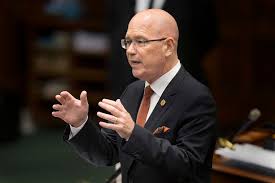 Minister Clark. Steve Clark, the Minister of Municipalities spoke at the AMO conference to talk about what he had in mind. He spoke the day after the Premier who made it clear that there were major cuts coming, what the province was going to pay for and what the municipalities were going to have to come up with.
It looked as if the Premier was going to find the money to pay down the provincial debt by forcing the municipalities to pick up more of the freight for the services they deliver.
Moody’s debt rating service said they thought the damage would amount to a $2 billion hit to the municipal sector.
Clark sugar coated everything his Ministry was going to do – it sounded like sunshine and lollipop pops or a verse from The Big Rock Candy Mountain.
It wasn’t until the very end of his speech that we got to see the sleeper – amalgamation is going to take place despite what Burlington’s MPP said.
Clark said: “At last year’s conference, I announced we would be reviewing the regional government system. It’s been in place for almost 50 years — and we wanted local input on how to improve governance, decision-making and service delivery.
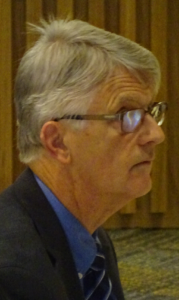 Michael Fenn “I’ve been unequivocal from day one and stated throughout the review — we have no preconceived outcomes” and added that “Ken Seiling and Michael Fenn are finalizing their recommendations — over 8,500 submissions and close to 100 in-person presentations were received — an overwhelming response — and I look forward to receiving their report.
“I’ll have more to say this fall. For now, I want to thank everyone who participated.”
Not so fast Minister.
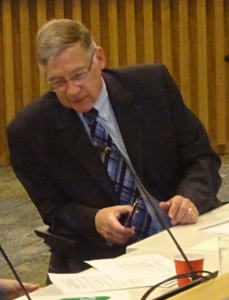 Ken Seiling When Seiling and Fenn were at Halton Region listening to delegations they mentioned that the event was their last stop and that they were ready to distill what they had heard into a report they would give the Minister by the end of July.
The concern for many at the Halton event was – would the report be made public. Seiling pointed out that they had been asked to do the work by the Minister and that the report would be given to the Minister – he would decide if and when it was to be made public.
There were delegations on how well the Region of Halton operated. Ken Seilling challenged an Oakville delegation that suggested the financial impact was going to be severe if there was any kind of amalgamation in Halton.
At the end of July we heard that the report would not be released until after the federal election.
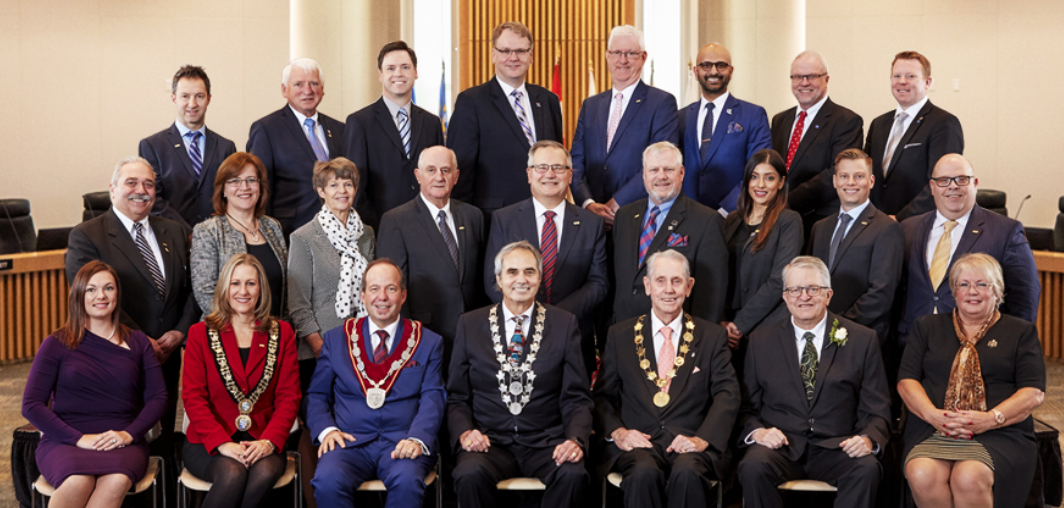 This Regional Council consists of ward representatives plus the Mayor from each municipality. Far too many people for Doug Ford’s liking. Yesterday we learned that it will not be on the table until next year.
Most people believe the report has been completed; that the Minister has read it and decided what the government will be doing.
It will have been discussed at Cabinet and there may well be bureaucrats creating new maps.
 Will these municipalities get down graded to being a ward in a city? Will Halton and it’s four municipalities be organized into something called the City of Halton? Far too early to know – what we do know is that Premier Ford is not shy when it comes to downsizing local government.
When he was in Oakville speaking to the Chambers of Commerce from the four municipalities, he was recognizing people in the audience. As he was reading out the names of those from Oakville he paused and said: “Boy, you’ve got a lot of people on that council.” The feeling that rippled across the Burlington Convention Centre was palpable.
Doug Ford thinks a Board of 7 to 9 people is what corporations need and he sees municipalities as corporate structures. Having people at the table who can effectively represent a community is not the role Ford sees for a politician.
His approach is to do it all himself. At that same event he read out his cell number and said ‘you can call me anytime’.
Doug Ford does not understand local politics, doesn’t respect the needs of communities at the grass roots level.
Expect the worst and hope that the very real representation problems in the Niagara Region get the attention they need and that Halton is left alone.
The Gazette got some comments from a former Ontario civil servant who served in several ministries who told us that he “would be very surprised if Clark has not been thoroughly briefed on what the report contains and its main recommendations. “
Our source added that he would “not be the least surprised if there was not some attempt to shape the main recommendations and right from the beginning of the process.
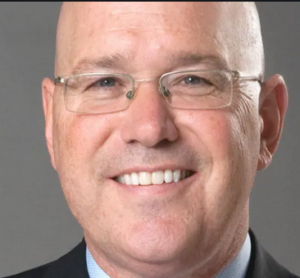 Minister of Municipalities Steve Clark: Already fully briefed? “Ministers never “receive” anything that they’ve formally commissioned until they’re ready. They are briefed at regular intervals so that there are ‘no surprises and the final report is an anti-climax at best.
“Well in advance of the formal transmission of the Fenn/Seiling report a fulsome communications strategy will have been developed, ready for precise deployment like the Normandy invasion.”
That invasion of citizen rights looks as if it is going to take place sometime early in the New Year.
Salt with Pepper is the musings, reflections and opinions of the publisher of the Burlington Gazette, an online newspaper that was formed in 2010 and is a member of the National Newsmedia Council.
Related new stories:
We Love Burlington delegates
Background on the Provincial Review of Regional governments
Edwardh describes Provincial Review as very limited

 By Vince Fiorito By Vince Fiorito
August 20th, 2019
BURLINGTON, ON
I agree with Doreen Nicol’s recent Burlington Gazette article.
City policy appears to harass people doing their part to fight climate change, the biodiversity crisis and environmental toxification problems.
Not only do Burlington’s current property standard by-laws appear to conflict with City Council’s recent climate change emergency declaration, they may also conflict with the Canadian Charter of Rights and Freedoms as well as the Species At Risk Act.
Imagine if Canada’s Group of Seven artists were held to the same standards as Burlington’s property standard bylaw, and they could only paint landscapes that were dominated by neatly mowed lawns.
 Landscape design, like painting, is an art form, which is protected by the Canadian Charter of Rights and Freedoms.  World class examples of native species based landscape designs, that would violate Burlington’s current property standards by-laws. Burlington’s by-laws and policies currently empower people who don’t understand or deny the existence of serious environmental problems. These people will pressure untrained city staff to mow what appears to them to be weedy unkempt looking lawns. Burlington residents shouldn’t have to fight with the city to be responsible stewards of the Earth. Some of them will inevitably take the city to court and seek damages and compensation.
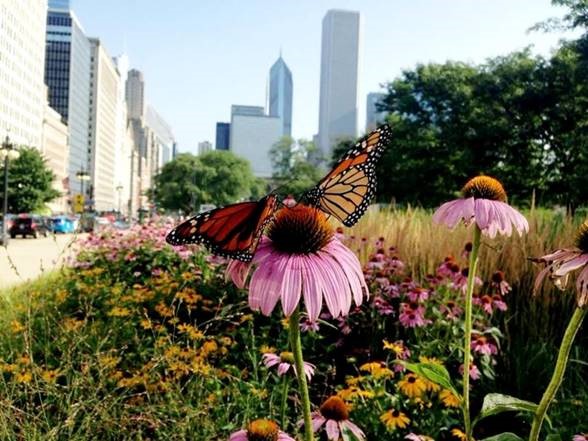 Urban monarch butterfly If city staff fail to recognize habitat for endangered species (Milkweed for Monarch Butterflies or New Jersey Tea for Mottled Duskywing Butterfly),then their actions could violate the Species At Risk Act and the city could risk fines up to $1,000,000
Also, modernizing and upgrading city property standards policies and by-laws, should include solutions to long term neglected environmental problems.
City policies and by-laws must encourage and assist property owners to clean up old dumpsites ASAP, like this one contaminated with old pesticide and petrochemical containers behind Creek Way in The Orchard.
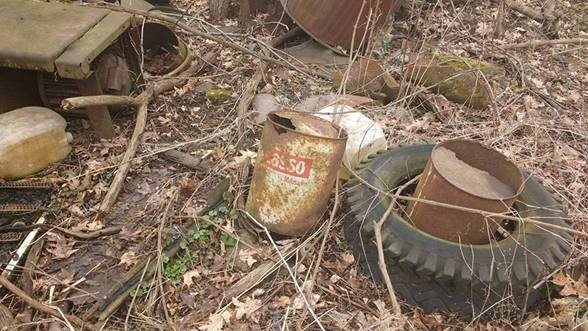 Located next to Sheldon Creek along the South Service Road, between Appleby and Burloak. 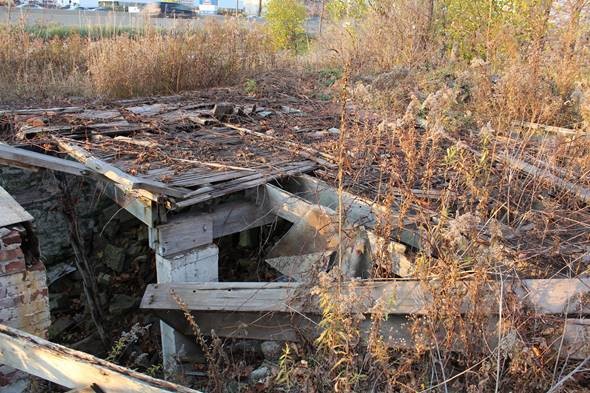 Current City property standards also ignore dangerous derelict buildings. City property standards allow local businesses to dump industrial effluent into our watersheds with impunity. The above has been reported repeatedly to all levels of government, and is legal. Residents living down stream from environmental problems must have a right to know.
They should not have to use the Freedom of Information Act to access information that the city be collecting and sharing. Ignorance isn’t bliss for children playing or fishing downstream.
 Rainbow Trout caught 200M downstream from the Harvester storm sewer  Chinook Salmon aught in Sheldon Creek near New Street – about 1km downstream from Harvester sewer. 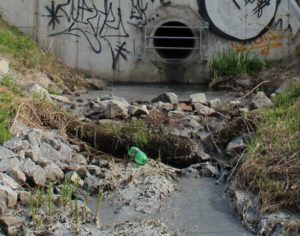 Harvester storm sewer Burlington must modernize and upgrade city policies to solve climate change, the biodiversity crisis and environmental toxification problems.
The city must have policies to inform residents of reported problems that may affect them and pressures property owners to remediate serious environmental problem or face punitive measures.
Burlington must protect and create habitat for the Halton region’s 48 endangered species, manage the health and improve the vitality of the city’s ravines and wildlife corridor system, give Burlington residents a “Right to Know” about local environmental problems and make polluters pay to clean up their messes.
This issue is an opportunity for city council and Burlington residents to treat the climate change emergency as an emergency.
No one should have to fight with the city to prevent future generations from inheriting a resource depleted dying planet.
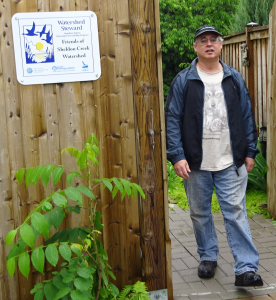 Vince Fiorito is a Burlington Resident and Founder of Friends of Sheldon Creek. He has also been named the Steward of Sheldon Creek by Conservation Halton. Vince Fiorito is a Burlington Resident and Founder of Friends of Sheldon Creek. He has also been named the Steward of Sheldon Creek by Conservation Halton.
Related news stories.
Activist points to significant by law abuse issues.
Resident wins argument over milk wood in her garden.

 By Staff By Staff
August 20th, 2019
BURLINGTON, ON
The Halton Regional Police Service found that working with its media made it possible for residents to be reunited with their stolen property.
On August 16, 2019, a Hamilton resident learned about the recovery results that came out of the arrest the Regional police made on July 4th.
 Much of a currency collection was recovered by police. Investigators in Burlington – 3 District Criminal Investigations Bureau were contacted and later reunited the victim with over 95% of the recovered stolen property.
Investigators are currently liaising with Hamilton Police and further charges are pending.
The remaining property can be seen by clicking here:
Anyone who may have additional information concerning this investigation is asked to contact Detective Constable Jacques Brunelle of the 3 District Criminal Investigations Bureau at 905-825-4747 ext. 2334 or the 3 District Criminal Investigations Bureau general line at 905-825-4747 ext. 2316.
Tips can also be submitted to Crime Stoppers “See Something? Hear Something? Know Something? Contact Crime Stoppers” at 1-800-222-8477 (TIPS), or through the web at www.haltoncrimestoppers.ca.
In the original media release the Halton Regional Police Service advised the public that they had arrested a suspect attempting to gain entry into the Kings Carwash located at 1448 Grahams Lane in Burlington. At the time of the arrest a large quantity of jewelry believed to be stolen was recovered and remains unaccounted for.
Bradley MARK (37) of no fixed address was charged with
• Break and Enter with intent
• Possession of Break in instruments
• Possession of property obtained by Crime
• Fail to comply with probation order
He was held pending a bail hearing.

 By Pepper Parr By Pepper Parr
August 20th, 2019
BURLINGTON, ON
 Jane McKenna yuks it up with guests at the Joseph Brant hospital annual meeting. A few months earlier, before she was elected, she wasn’t allowed to take part in a meeting with the Liberal Minister who was at the hospital to deliver a cheque.  Several reports say that Burlington MPP Jane McKenna has forsaken Twitter. Several reports say that Burlington MPP Jane McKenna has forsaken Twitter.
Probably a smart move – it wasn’t working all that well for her anyway.
Question is – did she do it herself or was she told to stay quiet?
Salt with Pepper is the musings, reflections and opinions of the publisher of the Burlington Gazette, an online newspaper that was formed in 2010 and is a member of the National Newsmedia Council.

 By Pepper Parr By Pepper Parr
August 20th, 2019
BURLINGTON, ON
When the Premier tried to download the costs of a number of services onto the municipalities some time ago, there was an uproar – they had already set their budgets and their tax rates – wasn’t possible to change at that point.
The Ford government relented; everyone knew they would be introducing the plans again – and they did – yesterday at the AMO conference taking place in Ottawa.
Child-care and health-care advocates are slamming the provincial government’s plan to go ahead with some of its controversial municipal funding cuts next year.
Despite some extra time before funding is slashed, the news was not welcome.
The cuts are real and they create “uncertainty, stress for families and sort of chaos at the municipal level across the province as they try to scramble to figure out what’s happening.”
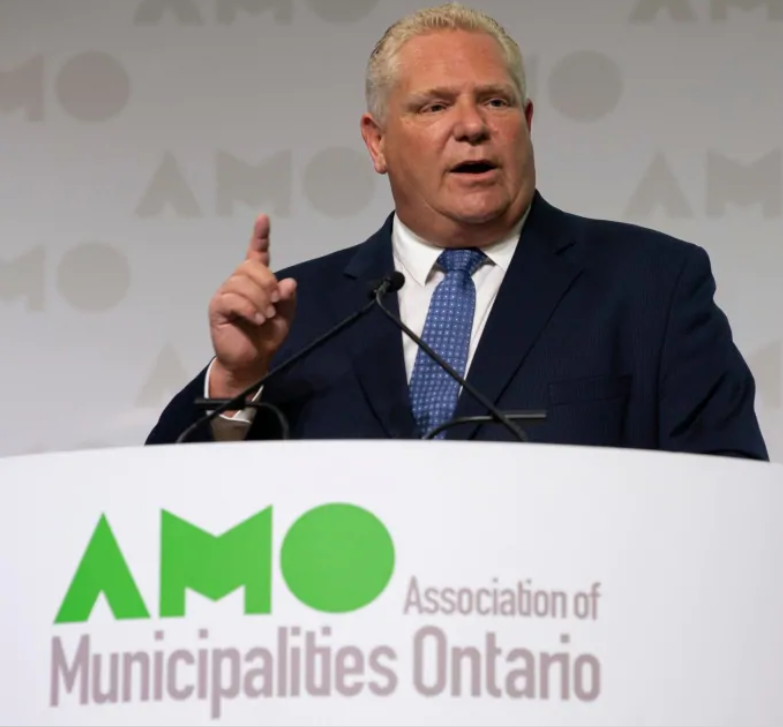 Premier Doug Ford addressing the municipal sector on Monday. Ford said some of this year’s planned cuts — to public health, child care and land ambulance funding — will take effect Jan. 1.
“We recognize our government moved quickly when we came into office to address our inherited challenges. But we’ve listened to you.”
Moody’s, the bond rating service, said the cuts will blow $2-billion hole in municipal budgets which will raise the cost of borrowing. Halton Regional Carr might not be able to brag about having the great credit rating the Region has had for more than a decade.
Prior to the changes announced by the Ford government last spring, municipalities had varying public health cost-sharing arrangements with the province — with Ontario paying 100 per cent or 75 per cent in some cases.
The new plan will see all municipalities pay 30 per cent of public health care costs.
The chair of Toronto’s board of health, said “officials are trying to figure out what the full financial impact of the cuts will be — but he was adamant that the cuts would amount to tens of millions of dollars annually for the city.”
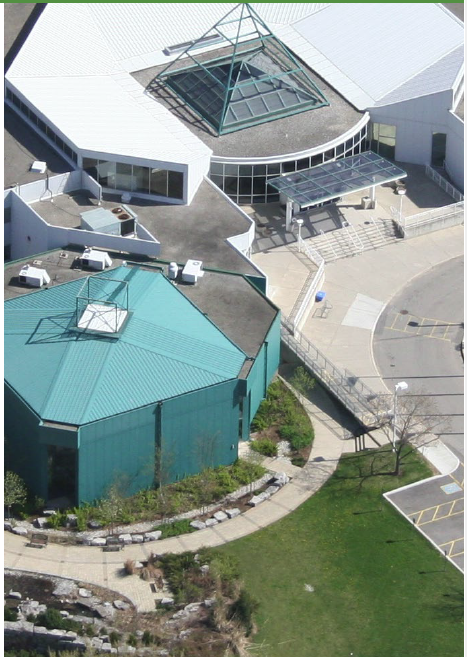 Aerial view of the Regional offices located in Oakville. Commissioners at the Region will be running their numbers when they get back to their offices – it is not going to be a pretty picture.
“As is too often the case with this provincial government, they make announcements first and provide details later.”
Starting on Jan. 1, municipalities will also have to pay 20 per cent of the cost of creating new child-care spaces, which the province previously fully funded.
Some cuts to funding for administrative child-care costs are being delayed until 2021 and others are being delayed to 2022.
Ford also said land ambulance funding will increase by four per cent.
The province is dealing with an $11 billion deficit, the highest sovereign debt of any government.
Just about all the Mayors “recognize and appreciate the challenges the government of Ontario faces in getting its deficit under control”. However, this must be done in a prudent, collaborative manner that does not impact the services that people rely on each and every day.”
A former city of Toronto Councillor said: “Make no mistake, these cuts will hurt people. They are short-sighted and they are wrong.”
Regional Chair and the CAO are going to have to confer with their commissioners to figure out how to deal with the funding cuts announced by the Ford government.
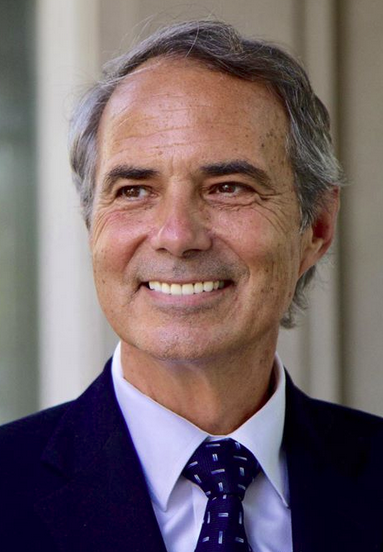 Regional Chair Gary Carr  Regional CAO Jane MacCaskill For weeks, the premier and his cabinet ministers had defended the cuts as necessary to tackle an urgent financial situation and said municipalities needed to do their part, as the recipients of a large share of provincial dollars. The government is trying to eliminate an $11.7 billion deficit.
AMO president Jamie McGarvey, who introduced Ford at the event Monday, said municipalities understand the province’s goals and urged the government to work with civic leaders.
“We cannot achieve these things with abrupt, unilateral changes and it will take more than simple belt tightening to make things better,” McGarvey said. “Working together, we can avoid unnecessary turmoil, and respect the essential front line-services that our governments deliver.”
The services that are going to be hit by funding cuts are for the most part delivered by the Regional government.
The tax rate that is set by a municipality includes taxes levied by the Region and the Boards of Education.

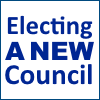 By Pepper Parr By Pepper Parr
August 20th, 2019
BURLINGTON, ON
How much of their own money did 2018 election candidates put up?
Some surprises.



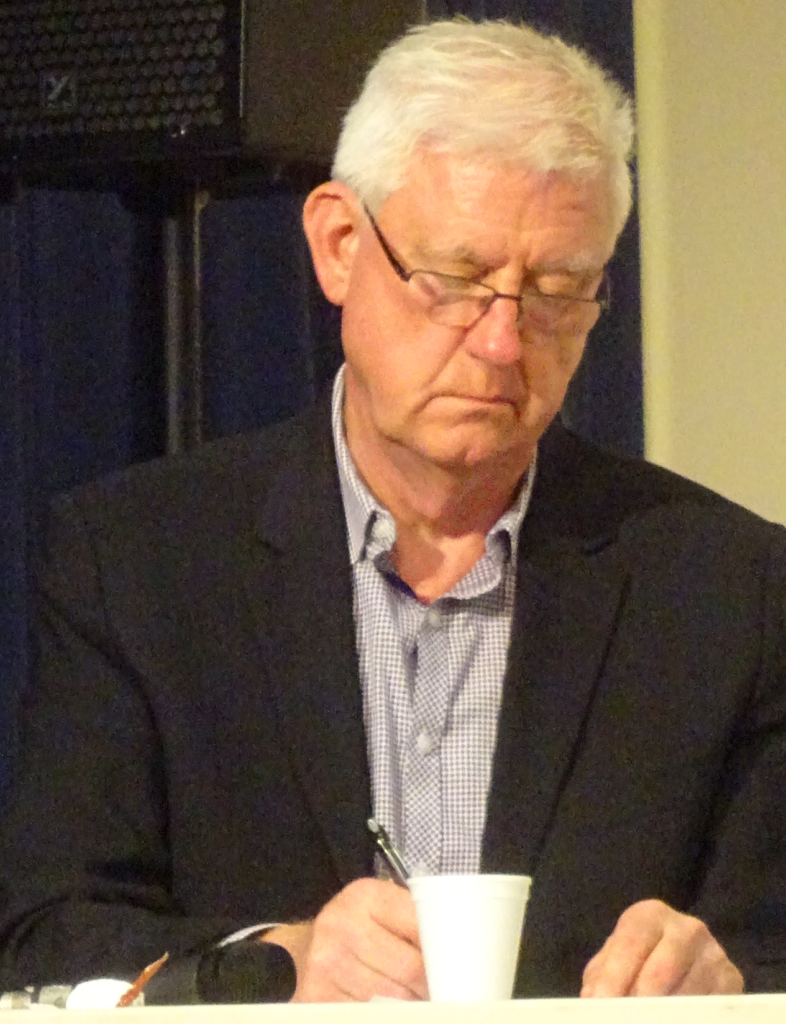 Paul Sharman taking part in a ward 5 election debate. Got a free ride financially. Sharman contributed $0 to his own campaign! The $250 shown was the value of old election signs he used in his 2014 election campaign.
 Running in ward 6 where she held the seat in 2010 ans 2014 Lancaster chose not to spend any of her own money – and lost by 41 votes. Lancaster also contributed $0 to her own campaign! The $180 shown was the value of old election signs she used in her 2014 election campaign.
Mike Wallace took the gamble of his life and put up $25,000 of his own money.
The following people reported 0 campaign donations:
Garry Milne, Andrew Jordan, Jason Boelhouwer, Gerard Shkuda and Michael Jones.
The following candidates failed to file election spending reports. They will not be permitted to run in the next municipal election. Walter Wiebe, Peter Rusin and Darcy Hutzel.
The data used was taken from the election finance returns filed by the candidates. Any errors or commissions will be corrected. Some of the forms were hand-written and very difficult to read.

 By Doreen Nicol By Doreen Nicol
August 20th, 2019
BURLINGTON, ON
The Gazette became aware of this situation earlier today.
You won’t know whether to laugh or cry. When things go amuck at city hall – they really go amuck.
The Mayor and much of Council is in Ottawa at the AMO conference – the Deputy Mayor is your best hope at this point to put a stop to this stupidity. Send an email to the Deputy Mayor and ask her to put a stop to this bit of nonsense.
On April 23, Burlington city council unanimously passed Ward 3 Councillor Rory Nisan’s motion to declare a climate emergency.
“By declaring a climate emergency, Burlington City Council is recognizing the magnitude of the challenge we face in combating climate change,” Nisan said in a press release. “But it is only one step. Through the declaration, we have requested a comprehensive climate action plan by the end of the year and that plan is where we will begin to make real, practical change for Burlington.”
According to local environmentalist Vince Fiorito, “Given the context of the city declaring a climate change emergency, noisy, smelly, green house gas emitting lawn mowers and leaf blowers should be discouraged.”
But a Burlington resident and her family are finding that the city is not living up to its promises. The resident in question has cultivated a naturalized garden area in their front yard to encourage genetic diversity, support native species, and create a supportive habitat for a variety of insects and local wildlife.
 A natural garden has the by-law enforcement people doing their duty. Fearing retribution from neighbours, I was asked to not use this resident’s real name so we’ll call her Antheia, after the goddess of flowers.
Antheia says, “I have been maintaining a naturalized area since 2015 and the City of Burlington has repeatedly told me I am in violation of the by-laws despite the by-laws allowing for naturalized areas. Every year they mischaracterize my naturalized area as a lawn and demand that I cut everything down to less than 8 inches or they will come and do it themselves and charge me.”
When the city inspected Antheia’s property in 2015, it took no action. In 2016, the city inspected the property again and issued a non-compliance notice. Antheia informed the city that she was maintaining a naturalized area as defined by bylaw No. 12-2011 as, “a yard or a portion of a yard containing vegetative growth that does not form part of a natural garden that has been deliberately implemented to produce ground cover, including one or more species of wildflowers, shrubs, perennials, grasses or combinations of them, whether native or non-native, consistent with a managed and natural landscape other than regularly mown grass.”
Antheia was informed by email and phone that the city could not qualify her property as a naturalized area, and that municipal employees would cut her plants to the required height for lawns of less than eight inches.
When city workers arrived to cut Antheia’s naturalized area, she called the police. The attending officers asked the workers to leave Antheia’s property. The officers left without incident and no further action was taken that year.
Then in 2017, without any notice, the city trespassed on Antheia’s property while she was not home and decimated the entire naturalized area. Milkweed, wild flowers, native species — many of which were perennials — and a bush were all cut to the required height for a lawn of less than eight inches. This effectively destroyed the portions of the garden needed by monarch butterflies, pollinators, birds, and small animals.
In 2018, the city made significant changes to the lot maintenance bylaw and replaced the law under which Antheia’s garden had been decimated, No. 12-2011, with new bylaw No. 59-2018. Antheia retained a lawyer to tell city workers to understand that she was maintaining a naturalized area. That summer the city took no action.
Things were looking good for Antheia’s case in 2019 after a bylaw enforcement officer deemed her property a naturalized area. But just a couple of weeks later, a second bylaw enforcement officer issued a non-compliance notice that mischaracterized the naturalized area as a lawn. Antheia was once again threatened with the destruction of her entire naturalized area.
Through discussions with a supervisor, Antheia was assured her property could be maintained as a naturalized area and was in fact in compliance. Yet, one month later, after allegedly receiving many complaints from neighbors, the city sent Antheia a letter demanding she cut everything — all the same plants that were in her yard when the city had deemed it in compliance — to less than eight inches.
Supported by countless research studies and anecdotal observations from native species gardeners, Antheia is absolutely right when she asserts, “Natural deep-rooted plants, like the ones on my property, are vital to helping the climate crisis. The deep roots from perennial species bring the carbon dioxide from the atmosphere down into the soil where it is locked away and stored. Each year I have seen many monarch butterflies drinking the nectar from, and laying their eggs on, the milkweed on my property. At a time when pollinator species are at risk, the city should be encouraging naturalized areas not trying to destroy them.”
Lawns are butterfly and pollinator deserts. But Canadians have been indoctrinated to believe that only a high maintenance manicured lawn of grass with a few strategically placed continuously flowering, non-native plants is acceptable landscaping.
Fiorito points out, “Landscape design is an art form. The Canadian Charter of Rights and Freedoms protects our right to freedom of artistic expression. The lawn and garden industry creates perceptions of problems where none exist to sell us their expensive solutions, many of which are real environmental problems.”
According to Fiorito, it’s hard to justify protecting lawns and not naturalized areas, “Given the current global biodiversity crisis and the fact that none of Halton Region’s 48 species at risk of extinction require grass to exist and thrive. Supporting lawns that take up space that could be better used to create habitat for local endangered species is hard to justify.”
So, it’s time that environmentalists, naturalized gardeners, and those people who want to leave a better world — one where there is hope for a future — to take a stand. Let the City of Burlington know that being given the distinction of being declared the No. 1 city in Canada by Maclean’s comes with responsibilities. Those responsibilities include living up to its commitment to address the climate emergency. Accepting and encouraging residents to embrace naturalized gardens — with their low carbon footprints, genetic diversity, and supportive ecosystems — is one small step towards fulfilling that commitment.
For everyone who wants to help save Antheia’s naturalized area before the city cuts it down on August 20 and for those who want to nudge Burlington closer to meeting the meteoric goal of taking a first step to putting the brakes on the climate crisis, here is the email address for the Deputy city manager – she may be the only person at city hall able to do something this week. Tanner can be reached at: marylou.tanner@burlington.ca
To inspire those of you who may be hesitant to help out, read my blog from last July when readers from across the country came together to let Burlington know that I shouldn’t have to remove my milkweed from my garden. One week later, the bylaw in question was changed.
 Doreen Nicoll is a freelance writer, teacher, social activist, and member of several community organizations working diligently to end poverty, hunger and gendered violence. she has had her share of run ins with the city. Doreen Nicoll is a freelance writer, teacher, social activist, and member of several community organizations working diligently to end poverty, hunger and gendered violence. she has had her share of run ins with the city.
Related news story:
Writer beats back city efforts to remove milkweed from her garden.

 By Staff By Staff
August 19th, 2019
BURLINGTON, ON
Those good folks at “We Love Burlington” believe, as do many municipal leaders and other community groups, that amalgamation is not only “on the table”, but likely was never off it.
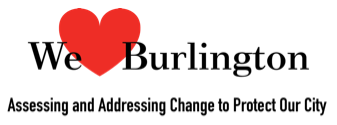 Perhaps the strategy of throwing so many pieces of legislation out at once is meant to make it impossible to keep up with all of them, and impossible to study each one carefully. This seems to be the theme of the provincial government to date. Perhaps the strategy of throwing so many pieces of legislation out at once is meant to make it impossible to keep up with all of them, and impossible to study each one carefully. This seems to be the theme of the provincial government to date.
 They really took a piece of Legislation from the Order Paper to the pen of the Lieutenant Governor in 31 days. There was Bill 5, which carried the amendments to the Municipal Act, the Municipal Elections Act and the City of Toronto Act (an omnibus bill) which allowed Premier Ford to reduce the size of Toronto Council in the midst of the 2018 Municipal election. We have written extensively (as have many others) about the disastrous “Developers’ Dream Bill”, Bill 108, which went from First Reading to Royal Assent in only 31 days, and as one municipal leader recently aptly put it to us “the outrages with the Bill are so numerous, you get numb.”
These are illustrative of the unilateral power over municipal structures and governance that the province can and is wielding. They are also examples of what the province can easily do to effect regional restructuring.
On August 8th, Premier Ford was in Fonthill and at an impromptu press conference, stated that amalgamation is going ahead in Ontario. The following was taken from a QP Briefing article that was published in the Toronto Star later that day: “A freewheeling Premier Doug Ford gave a clear indication that some Ontario municipalities can expect amalgamation in the near future. The premier decried the number of politicians in the Niagara Region as he spontaneously chose to field questions from reporters at an announcement in Fonthill.
 On this occasion the Premier was helping a child blow bubbles – most of the time many think he is just blowing smoke. When asked by a local reporter about the potential amalgamation that could affect the Niagara region and many other Ontario municipalities, Ford led off by saying it’s under review by Municipal Affairs Minister Steve Clark, but then outlined what outcome makes sense to him. “Minister Clark is going to be rolling that out over the next little while,” But then Ford said that he would prefer fewer politicians, based on what he’s heard from residents. “Go door-knocking in the area. It’s almost comical. You’ve got 136 politicians for 400,000 people. Something’s wrong,” said the premier.
The premier argued it’s a matter of saving money. “That’s just wasting taxpayers’ money. But I have all the confidence in the world in Minister Clark to straighten out any of those issues, and make sure we respect the taxpayers and run a leaner, more efficient government,” he said. He added that residents have told him they don’t like the number of politicians they have. “I’ve heard it from them — they aren’t too happy about that.”
Interesting as well was the comment made by the Premier when he addressed the Halton Chambers of Commerce at a Burlington event.
As he was reading out the names of the municipal Councillors in the room he paused as he was going through the list of those from Oakville and said: “Gee you got a lot of council members in Oakville.”
There was a palpable shudder that went through the room.
Study after study, including the 2015 Fraser Report that studied Ontario amalgamations (https://www.fraserinstitute.org/research/municipal-amalgamation-ontario) say that in fact, prior Ontario amalgamations resulted in “significant increases in property taxes, remuneration and long-term debt.” We attach, for those who may not have seen it before, the text of our delegation to the regional reviewers in May, which outlines our concerns more specifically. The continued downloading onto municipalities does not serve the citizenry; there is only one taxpayer.
This week the core of basically every municipality in the province is in Ottawa at the AMO conference. We are aware of one Halton municipal Councillor who is “taking the Missus” with him – there is a man who knows how to have a good time.
The Ministry of Municipal Affairs announced that the Minister will be addressing the AMO crowd; Councillors will be listening with baited breath.
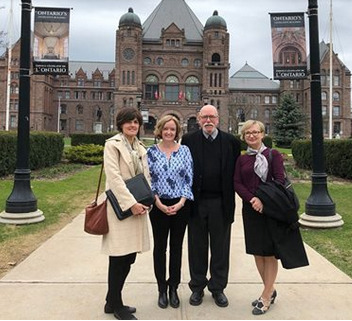 The Lovelies: Debra Rouse, Lynn Crosby, Blair Smith and Josie Wagstaffe after a visit to Queen’s Park
The Lovelies (a colloquial description for the We Love Burlington band of advocates) believe that “the threat of amalgamation is very real and that new mapping of the 82 municipalities is already being carried out. We believe that there will either be amalgamation of our four Halton municipalities (Burlington, Oakville, Milton, Halton Hills) into the City of Halton, with likely only six councillors and a mayor for a population of 600,000 people (the same ratio of councillors to citizens that the City of Toronto now has, and which aligns with Premier Ford’s recent comments that in the corporate world, an ideal size of a board of directors is 7 to 9) or that the provincial government will maintain the local identities, but take away much of the local authority. This in effect would have much the same result as full amalgamation.”
 Steve Clark: Minister of Municipal Affairs and Housing. It will be interesting to hear what the Minister has to say on Wednesday and whether or not his views align with the report due from the Provincial Review panel that listened to all the municipalities and have a report that was to be released in July.
The release date was moved back until after the federal election in October.

 By Pepper Parr By Pepper Parr
August 19th, 2019
Burlington, ON
There are some people who do not hold public office, were not the subject of significant media coverage – they just lived their lives and when their time came, they died.
Immediate family and the circle of close friends grieve the loss and time moves on.
On July 31st Burlington resident and D-Day veteran William B. McConnell died.
McConnell was not a native of Burlington – he discovered Burlington and chose to live here while on a vacation. He was single all his life.
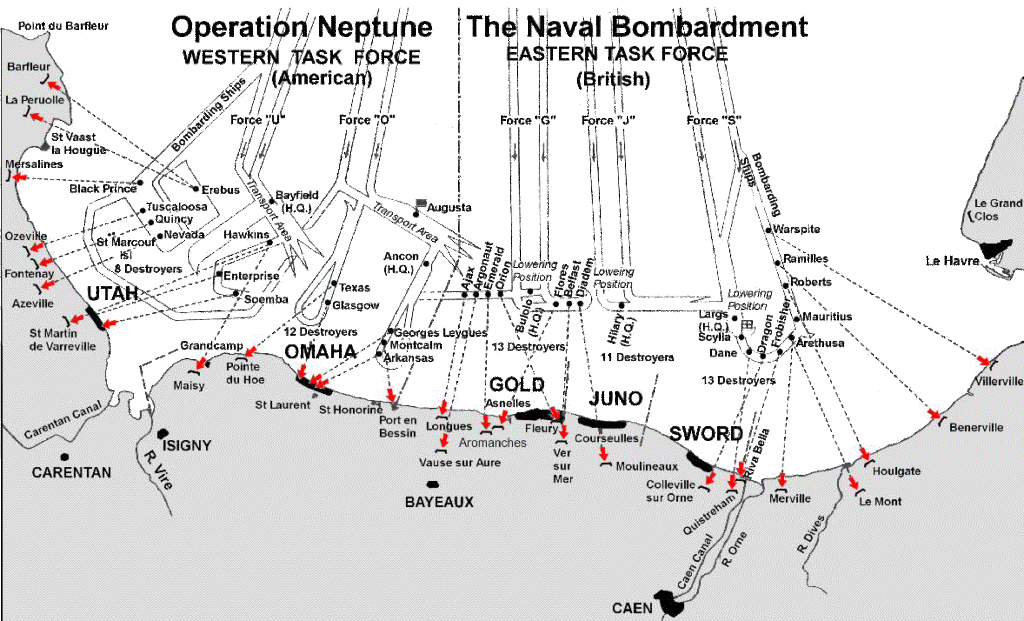 HMS Ramillies was part of the naval support on DDay. She was tasked with taking out German guns at Benneville shown on the far right. They needed just 80 minutes to destroy most of the German guns On D Day McConnell was aboard HMS Ramillies, a WWI relic of a battleship that was deemed fit for service. The battleship’s assignment was to train its 16 inch guns on a German battery with six 6” guns at Beneville, France, to the east end of Sword Beach. The Ramillies took out four of those gun batteries in 80 minutes.
McConnell was what you would call an electrician these days – in his time, electronics were pretty rudimentary.
It was during this battle that Bill had to go aloft to the Aloft Director to repair some electrical equipment. The Aloft Director is the station high up on the ship that was used for observation.
The Allied landings on the Beaches of Normandy France were ferocious battles; thousands of men were lost. It was, however, the battle that turned the tide and the beginning of the Liberation of France.
While the guns were blazing three torpedoes sped past the battleship – two on one side, one on the other.
Battleships were huge and carried four 16 inch guns that sometimes were fired so often that the paint burned off the barrels. We rattle off that phrase “16 inch guns” quickly when we are talking about a big bullet that measures a foot and a half wide. The roar of the shell coming out of a barrel, four of them at the same time, pushes that battle ship sideways.
During the bombardment there was a problem with electrical fittings in the Aloft Directory of the ship.
This was an observation level high up in the rigging with access possible only by climbing up a rope ladder.
It was while he was climbing from level to level that the 16 inch guns roared – instantly deafening McConnell. Bill was not able to put his hands over his ears because, as he put it, “you can’t cover both ears, hold the ladder and your tool kit at the same time”. The deafness was complete in on ear and seriously in the other.
Bill joined the navy at the age of 11. He was at the Royal Hospital School, which was part of the British Navy at the time. It was basically a boarding school where the students wore uniforms. Bill’s father was a Gunnery Chief Petty Officer and was at sea most of the time.
When it was clear there was going to be a war in 1938, Bill found himself doing paperwork related to reserve naval types being called up. It was a situation where 15 year old boys were doing the paper work that brought men, some 60 years of age, back into the service.
It wasn’t long after that Bill was being trained as an Electrical Artificer and soon he was off to sea
After the D Day landings, and McConnell recovered as much as he was going to be able to, Bill stayed in the Navy and left in 1953 after fifteen years of service.
As a civilian his skills were quickly put to use as he worked for the next sixteen years in the development, installation and acceptance testing of guns and missile controls.
While on a vacation to Canada he found a job working on the “Sea Sparrow” missile control systems for the Canadian DDH280 destroyers. Burlington became his home.
 Legion d’Honneur awarded by the President of the Republic of France to William (Bill) Basil McConnell. In 2016, on the 70th Anniversary of the war ending, the French government decided to make anyone who was involved in the landings a member of the Legion d’Honneur – the Legion of Honour.
The ceremony took place aboard the retired Tribal Class destroyer HMCS Haida, tied up in Hamilton at HMCS Star.
During the ceremony Colonel Vandomm read a document that said: “By order of the President of the Republic of France, you have been awarded the rank of Knight of the French National Order of the Legion of Honour.
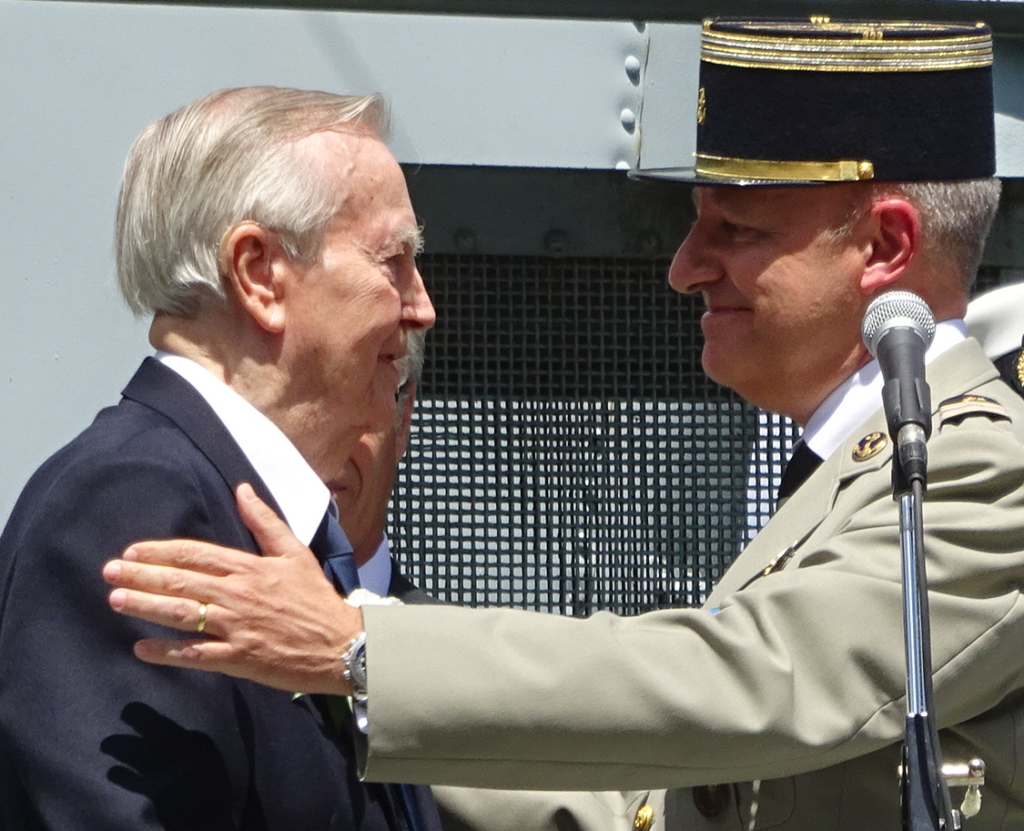 Retired Chief Petty Officer William (Bill) Basil McConnell being congratulated by Colonel Roger Vandomm during the awarding of the French Legion of Honour medal. Chief Petty Officer William Basil McConnell being awarded the French Legion of Honour by Colonel Roger Vandomm. The smile of appreciation on the Colonel’s face told the story.
“This distinction, the highest national order of France, illustrates the profound gratitude France would like to express to you in recognition of your personal involvement of the liberation of our country during World War II.”
The Mayor of Burlington released a statement when her office was made aware of Bill’s passing. He deserved more mention than a formal statement. Rest in Peace Bill.

 By Staff By Staff
August 19th, 2019
BURLINGTON, ON
On July 4th 2019, the Halton Regional Police Service arrested a suspect early in July who was attempting to gain entry into the Kings Carwash located at 1448 Grahams Lane in the City of Burlington.
At the time of the arrest a large quantity of jewelry believed to be stolen was recovered and remains unaccounted for.
Arrested:
Bradley MARK (37) of no fixed address
Charges:
• Break and Enter with intent
• Possession of Break in instruments
• Possession of property obtained by Crime
• Fail to comply with probation order
The accused was held pending a bail hearing.
 Classic watch – very valuable. If you are a victim of a residential break in on or prior to July 4th 2019, please click the below link and review the photos on our Flickr account. If you are the rightful owner and can identify any of the property please contact us.
Link to property photos: https://bit.ly/2YyLSEf
Anyone who may have additional information concerning this investigation is asked to contact Detective Constable Jacques Brunelle of the 3 District Criminal Investigations Bureau at 905-825-4747 ext. 2334 or the 3 District Criminal Investigations Bureau general line at 905-825-4747 ext. 2316.
 A collectable – how many people recognize the brand? Tips can also be submitted to Crime Stoppers “See Something? Hear Something? Know Something? Contact Crime Stoppers” at 1-800-222-8477 (TIPS), or through the web at www.haltoncrimestoppers.ca.
People charged with a criminal offence are presumed innocent until proven guilty in a court of law.

 By Pepper Parr By Pepper Parr
August 16th, 2019
BURLINGTON, ON
The Gazette has been doing a series of articles on the amount of money that was raised and spent during the October municipal election.
We are going to do this on a ward by ward basis and at the same time provide some demographic data on the makeup of the ward. Reports have been done on wards 3 and 4.
The demographic data will give readers a drilled down look at the community they live in and how their member of Council got elected and who paid for that election.
Ward 1 is being done in two parts; the well-financed campaigns and candidates that got decent vote counts and those who were running for reasons known only to themselves.
Each candidate was given an amount they could spend; that number came for the Clerk’s office who used Statistics Canada numbers.
In the data set out below the TCI (Total Campaign Income) is the total dollar amount brought in by each campaign. The TAE (Total Applicable Expenditures) is the TCI minus any applicable expenses. It is the total applicable expenditures or the total expenditures that apply to the Total Spending Limit and must be less that the Total Spending Limit. We then took the TAE and calculated it as a % of the TSL (also called “The General Spending Limit). So if someone had a TAE of $7 and the TSL/GSL was $10, then they spent 70% of the allowable campaign limit.


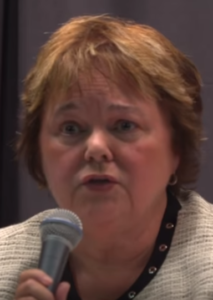 Judy Worsley  Kelven Galbraith 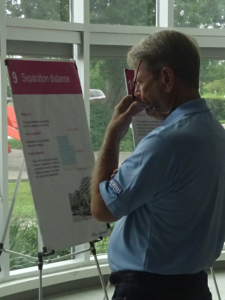 Marty Staz Campaign donations. The numbers in yellow are donations that came from people believed to be developers.
Judy Worsley campaign donations:
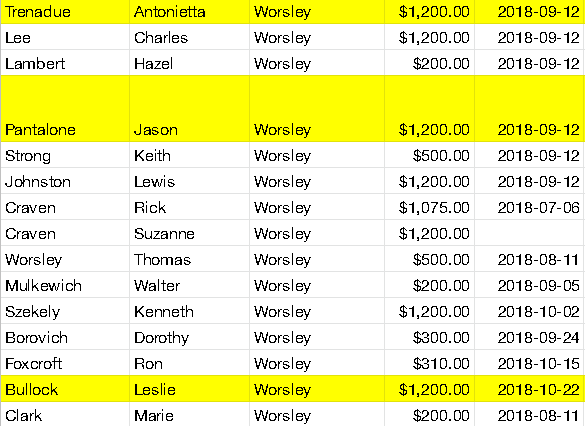
Kelven Galbraith campaign donations:

Marty Staz campaign donations:

Arlene Iantomassi campaign donations
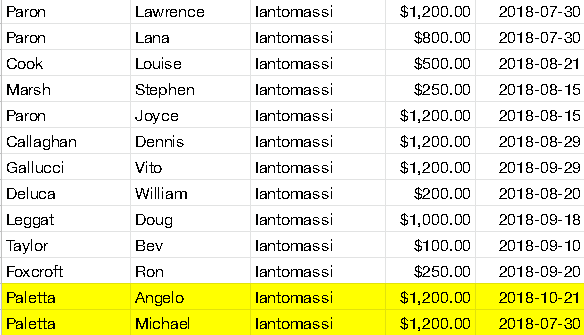
Did funds from developers make a difference? It wouldn’t appear so.
At look at the demographic make up of the ward.
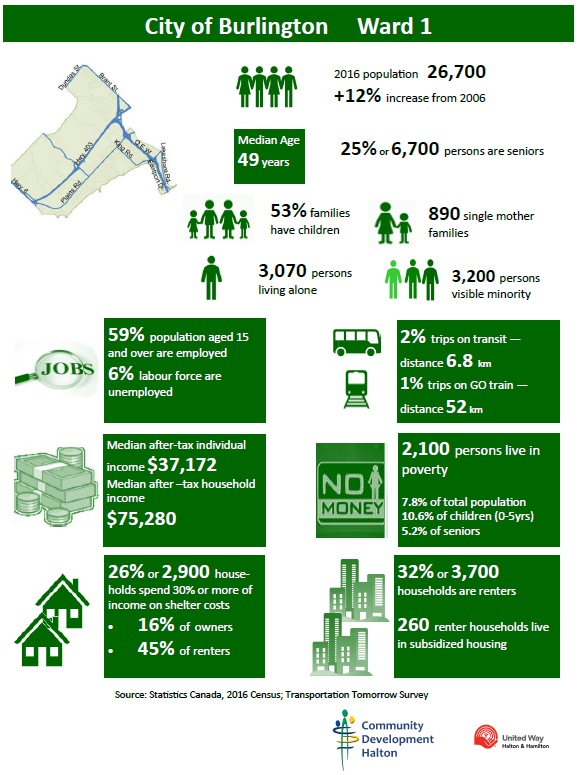

 By Staff By Staff
August 16th, 2019
BURLINGTON, ON
It’s old news to Burlington – we got hit for just half a million. The City of Saskatoon says it has lost $1 million in an online scam.
An avid Gazette reader brought this one to our attention
 Internet scam artists have figured out that there is all kinds of money at city hall and there are people who will give it to you. Saskatoon City manager Jeff Jorgenson says a fraudster electronically impersonated the chief financial officer of a construction company that has a contract with the city.
He says the culprit asked to have a payment sent to a new bank account and the city complied.
It has hired experts to try to recover the money.
Burlington might want to get the name of that expert.
Saskatoon is reviewing its financial controls to make sure it is secure from future attacks.
“The fraudsters are becoming more and more sophisticated, and our controls and systems have to become more and more sophisticated as well.”
Saskatoon’s Mayor decided to go public with the fraud to be up front with taxpayers and warn others so it doesn’t happen to them.
Two years ago, MacEwan University in Edmonton reported that it had been defrauded of $11.8 million when three staff members were fooled into changing the electronic banking information of a construction company.
Having loosey goosey security procedures in place didn’t keep us off the Macleans magazine Best Place to Live list.

 By Staff By Staff
August 16th, 2019
BURLINGTON, ON
 Record inflows from Lake Erie are expected to continue which impacts water levels in Lake Ontario. Record inflows from Lake Erie are expected to continue which impacts water levels in Lake Ontario.
Add significant rainfall to that and local flood warnings become very real. It will be a decade more before the damage done by the August 2014 flood has left our psyches.
The latest information provided by the International Lake Ontario – St. Lawrence River Board (ILOSLRB) indicates that Lake Ontario reached a mean daily water level of 75.57 m on August 13th, declining by approximately 1cm per day during the preceding week. The latest water level is 35 cm below this year’s peak level (recorded on June 15th) and remains 64 cm above average but is now 6 cm below the record level for this time of year set in 1947.
 Burlington knows what a flash flood look like and the damage they can do. With Climate Change a part of our lives weather warnings need to get tighter attention. Record high outflows (equivalent to the peak releases during June to August of 2017, but having now surpassed the interval of those outflows in 2017) continue to be released to lower the lake level and provide some relief to shoreline stakeholders, while also considering the effects of higher flows on interests in the St. Lawrence River.
Lake Ontario levels are expected to continue to slowly decline in the coming days, with the forecasted drier conditions combined with the continuation of record-high outflows. Notwithstanding, water levels will remain elevated for the next several weeks and into the late summer months as record inflows from Lake Erie are expected to continue.
All shoreline areas should be considered dangerous during this time. Localized flooding combined with the potential for waves to overtop breakwalls and other shoreline structures continue to make these locations extremely dangerous. Conservation Halton is asking all residents to exercise caution around Lake Ontario shoreline areas and to alert children in your care of these imminent dangers.
This Flood Watch – Lake Ontario Shoreline message will remain in effect until August 22nd. Conservation Halton will continue to monitor Lake Ontario wind conditions and lake levels closely and will either terminate this message or issue further updates as necessary.
Additional information is available online through the ILOSLRB website and on Facebook:
Current Conditions: https://ijc.org/en/loslrb/watershed/current-conditions
Forecasts: https://ijc.org/en/loslrb/watershed/forecasts

 By Staff By Staff
August 16th, 2019
BURLINGTON, ON
City hall is reminding people that there are public engagement opportunities now underway to help shape the adopted Official Plan policies that will guide development in the downtown core.
They want to know what matters most to you about downtown Burlington.
Their hope is that they (the planners) can work to gather public feedback about the downtown policies in Burlington’s adopted Official Plan. The process begins with a series of pop-up events. Additional public engagement opportunities to share ideas that will help refine and improve the downtown policies include two Citizen Action Labs taking place on Thursday, Aug. 22 and an online survey available at www.getinvolvedburlington.ca
All four buildings are within a five minute walk of each other. These are basically done deals with others in the planning stage. If this is what you want – say so – If this isn’t what you want speak up.
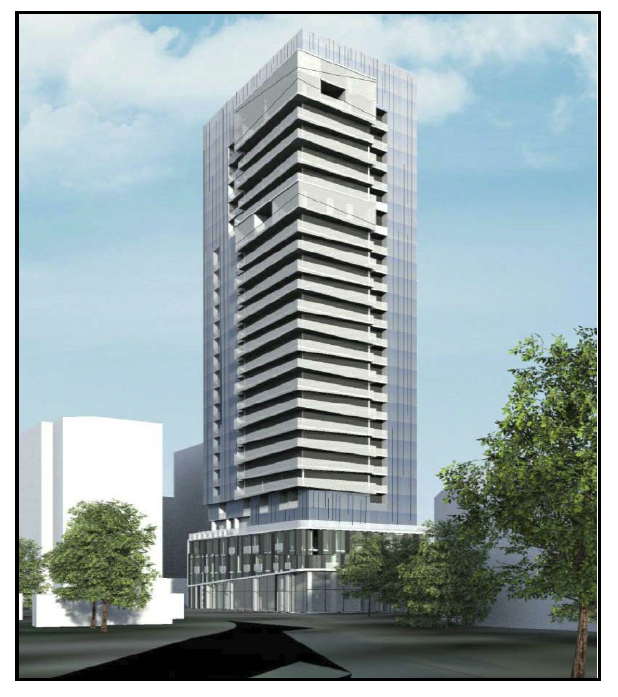 The Nautique – shovels will be in the ground within months and take close to three years to complete.  Due to go up across the street from city hall. 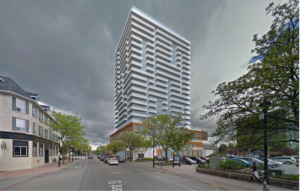 Approved for 17 floors – developer wants 26 – has appealed. To go up opposite city hall as well. 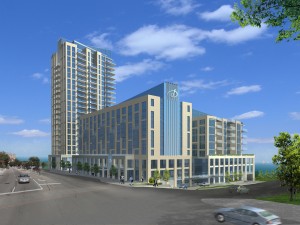 Completion has stalled – they need another year to complete the job. Pop up Events
City staff will be visiting a variety of locations and events throughout the community to talk with residents and identify what is most important to them about downtown Burlington. They really want to hear what the average person thinks. During the October municipal election people complained that city hall wasn’t listening. They are listening now. Let them hear what you have to say.
Pop-up Dates and Locations
Friday, Aug. 16 Burlington Farmer’s Market, 777 Guelph Line 9 a.m. to 1 p.m.
Saturday, Aug. 17 Spencer Smith Park (playground), 1400 Lakeshore Rd.
Tansley Woods Library, 1996 Itabashi Way
11 a.m. to 1 p.m. & 2 to 4 p.m.
Sunday, Aug. 18 Burlington Performing Arts Centre, 440 Locust St.
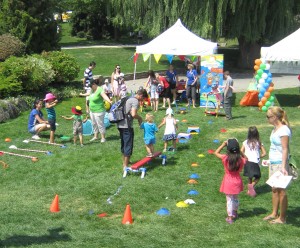 Children’s Festival will be taking place on the weekend – planners will be out in force asking for your opinion. Children’s Festival, Spencer Smith Park, 1400 Lakeshore Rd
Central Park (bandshell), 2299 New St.
11 a.m. to 12 p.m. & 7 to 7:30 p.m.
Monday, Aug. 19 Alton Library at Haber Community Centre, 3040 Tim Dobbie Dr.
5:30 to 7 p.m.
Tuesday, Aug. 20 Appleby Arena, 1201 Appleby Line
Brant Hills Library, 2255 Brant St.
12:30 to 2 p.m. & 6 to 8 p.m.
Wednesday, Aug. 21
Brant Hills Library, 2255 Brant St. 11:30 a.m. to 2:30 p.m.
Saturday, Aug. 24 Burlington Farmer’s Market, 777 Guelph Line
Aldershot Farmer’s Market, 484 Plains Rd. E. 8 a.m. to 2 p.m.
Citizen Action Labs – Taking a Closer Look at the Downtown
At these public meetings, participants will work in small groups to discuss and identify what is most important to them about downtown Burlington.
Thursday, Aug. 22
1 to 3 p.m. or 7 to 9 p.m.
Art Gallery of Burlington, 1333 Lakeshore Rd.
Online Survey
An online survey will be available until Aug. 30 at www.getinvolvedburlington.ca to share input about what matters most about downtown Burlington.
Feedback gathered from all the public engagement activities will be used to inform the creation of two concepts of what the downtown could look like in the future. These concepts will be shared with the public in the fall for review and further input.
Visit www.GetInvolvedBurlington.ca to learn more about the re-examination of the downtown policies in the adopted Official Plan and upcoming engagement opportunities.
 Not everyone sees the process city hall is using to gather feedback as the best there is. ECoB Engaged Citizens of Burlington, the group that organized the public debates in every ward that was to a considerable degree responsible for the changes at city council have written the planners with their concerns. Not everyone sees the process city hall is using to gather feedback as the best there is. ECoB Engaged Citizens of Burlington, the group that organized the public debates in every ward that was to a considerable degree responsible for the changes at city council have written the planners with their concerns.
1. The Feedback summary of comment and advice received during the pre-engagement process includes a broadly fair summary of comments provided by ECoB during our meeting with the planning department.
2. Our impression in meeting with the Planning Department staff was of a good faith intention to carry out a better engagement process during the Official Plan Review than has been made in the past. ECoB welcomes the growing recognition of effective and genuine engagement in city decision-making processes. ECoB welcomes the opportunity to take part.
3. ‘Doing engagement right’ is a difficult, time-consuming and potentially costly process. It is important to recognize at the outset that the extremely restricted timescales will of necessity create an imperfect engagement process. While the OP Review provides an opportunity for limited additional input from residents over what was received in the initial ‘Grow Bold’ process, it will still be far short of what we would consider the ideal engagement process for a new Official Plan. We believe it is better to recognize these shortcomings now than to argue that a comprehensive engagement process can be carried out in the time available. This observation may be valuable in future engagement initiatives and the ongoing review of advisory committees and engagement in general.
4. The feedback received has been made anonymous in the summary sent to us. We believe it would in fact be advantageous to know which comments came from which groups and individuals. Purely as an example, one can guess that the stipulation that the Engagement Charter be referenced frequently came from the ChAT team. Likewise, there was contrasting advice on ‘pop-up’ engagement processes. Knowing who gave this advice might clarify why there is a discrepancy in opinion. The source of advice is highly relevant in assessing the value of feedback received, and for those attempting to understand how the engagement plan was formed. We believe there is no reason why the names and affiliations of all people consulted could not be included, in the interests of openness and transparency.
5. The pre-engagement process primarily involved receiving advice from advisory committees of various sorts. Only two organizations (ECoB and the Hamilton-Halton Home Builders Assoc.) are fully independent of City Hall. It would further clarify to know who, if any individuals were consulted and to ascertain their independence. ECoB’s position is that the current make-up and selection processes for advisory committees is in urgent need for reform, as recommended by the Shape Burlington Report in 2010, but not implemented. Ironically, most advisory committees, including ChAT, do not regularly interact with the public. There is a perception of a lack of transparency in the selection of citizen volunteers and the operations of the ChAT group. With the greatest of respect for the volunteers on the committees, some of whom are also ECoB members, these longstanding procedural problems weaken the validity of advice received.
6. Having consulted with our members and executive over the last week, there is certainly still concern among our membership that the engagement process will remain too superficial. As we stated during our meeting, we strongly encourage the planning department to ‘be bold’ with the engagement that it conducts to go beyond conventional methods. This should include acknowledgement of and clearly stated attempts to reach:
◦ People from all age groups. Meetings with school-age children a year or so from adulthood are easy and quick to arrange through civics classes and may provide a different but important perspective. The same goes for seniors groups (albeit seniors are traditionally well represented in ‘volunteered feedback’), but also commuters and young families. ‘Pop- up’ events may be most valuable if held, for instance, at ice-rinks or venues where young families take children to participate in sport, as well as malls and supermarkets.
◦ People of different ethnicities. Reaching out to local religious and cultural organizations can be an easy way to ensure people of different ethnic and cultural backgrounds are included.
◦ People of different income groups. Again, religious organizations and local and regional non-profits can advise on the many events and gatherings organized for people on low incomes.
Unless attempts to meet and address these groups are explicitly mentioned in the engagement plan, they are highly likely to be overlooked.
7. We mentioned during our meeting, but it is not included in the summary, the possibility of using local organizations to help with engagement. This would need to be done in a way such that the volunteer groups could not influence the information collected. Such groups could assist with delivery and collection of questionnaires, or explaining the engagement process to people who would traditionally not participate.
8. We did not mention at our meeting but would like to add the suggestion of an important education component to assist residents with learning about the planning process. A fear of a lack of knowledge is a major barrier to people participating in engagement activities. Such a program was provided for new councillors in 2018 – it could be adapted for the public. While the most frequently engaged residents become aware of the complexity of the issues at hand, other residents are naturally less well-informed. This can lead to unrealistic impressions of what is feasible in the provincial and regional planning context and to repetitive and time consuming covering of the same ground. This is where a prominent educational component, presented as separate educational meetings, plus a website and/or documentation, would be of value to both planning staffs and citizens.
9. Re: “Trade-offs and options – Avoid oversimplifying discussion to height alone”
By contrast lack of background information or education must not invalidate resident opinions. This phrase copied above embodies some of the problems that frequently arise when institutions undertake engagement. It is imperative that when questions are asked of residents, they are not asked in ways that lead to institutionally-desired responses. An example of such a ‘trade-off’ question is: “Would you be willing to accept additional height in return for a medical facility included in a development”. Height is a huge issue for many residents, and that opinion has to be recognised and acknowledged alongside all others, regardless of how problematic it is marry that desire with the current provincial planning context.
“Maintaining low-rise to mid-rise character”, or “lower heights in downtown”, are perfectly valid desires for a residents to have, and residents should neither be patronized to by an inference that they “don’t understand”, nor should their opinions be hidden by using engagement processes which lead to minimizing widely held opinions.
In summary – it is the purpose of engagement to find out what residents and other ‘stakeholders’ want, and then to see how the OP Review can best satisfy those desires within the context of the in force provincial and regional planning frameworks. It is not the job of engagement to shape opinion in ways which may appear more convenient.
10. Some of the most ‘scientifically’ valid and innovative methods of engagement available are being ruled out by time and budget. While time is certainly an issue, we would urge the City to consider an increased budget if it allows engagement at a scale, and of a validity, that has not been achieved before. The key objective must be to reach a representative sample of the vast majority of residents who, for entirely valid reasons, do not take participate in conventional engagement opportunities. We feel dollars spent at this stage will save expenses and points of conflict at a later date if an OP is put together that residents can broadly support.
Conclusion
The summary of pre-engagement gives a reasonable reflection of the advice we provided at our meeting with the Planning Department, and we have noted some items which we think could have been included. We do have concerns that some of the same processes which failed citizens in previous OP engagement efforts are likely to be repeated. Nevertheless, we believe the Planning Department is moving in a better direction with regard to engagement. Cognizant of the shortcomings of previous engagement exercises, we would like to see additional weight given to engagement methods by which “the city goes out to residents ”and not “residents coming to the city” thereby reaching out in as representative a manner as a manner as possible to the entire population.
While the timelines are extremely short, we still believe the City should set ambitious engagement objectives. If doing so demands additional budget, we believe the City Manager and Council should make the funds available urgently to ‘do engagement right’.

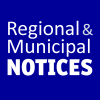 By Staff By Staff
August 16th, 2019
BURLINGTON, ON
 Due to an unexpected mechanical failure at the Dofasco Waterjet Plaza at Spencer Smith Park, the spray pad will be closed until further notice. Due to an unexpected mechanical failure at the Dofasco Waterjet Plaza at Spencer Smith Park, the spray pad will be closed until further notice.
Staff are working to identify and repair the issue but the repair is expected to take several days and will not be available for the Children’s Festival this weekend.

 By Staff By Staff
August 15th, 2019
BURLINGTON, ON
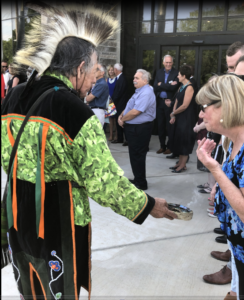 Elder Garry Sault of the Mississaugas of the Credit First Nation shares a traditional smudging ceremony with Museums of Burlington Executive Director, Barb Teatero. A traditional Smudging Ceremony, led by Elder Garry Sault of the Mississaugas of the Credit First Nation took place yesterday as three levels of government, project funders and donors were given a preview of the transformed Joseph Brant Museum.
The museum will officially open to the public on Sunday, September 15, with a community celebration from noon to 4 p.m. at 1240 North Shore Blvd. E.
The celebration will feature tours, interactive exhibits, activities and an official ribbon cutting with Burlington Mayor Meed Ward.
The public will get to see newly appointed Director Kimberly Anne Watson, who was named to the position effective September 9th
The Joseph Brant Museum, that sat by itself on the land that was granted to Joseph Brant for his service to the British who he served as a Captain, was a 1937 replica of the house Brant, Thayendanegea, built on a 1798 Crown land grant.
The addition to the museum has been built into the grassy area under the previous museum which adds more than 12,000 square feet of space to the museum.
The hope is that the expansion will make the Museum a cultural destination and a place to host national exhibitions and the collection of artifacts.
The first travelling exhibit has been announced – it is a display of classic pinball machines from a museum in Cleveland which gives a whole new meaning to a cultural destination.
The transformed museum has been expanded to provide barrier-free space, including an elevator to the second-floor roof garden and the Brant home that will serve as administrative space. The expansion includes more room for gallery displays, interactive programming, the storage of collections and community outreach.
• Total square footage of expanded site: 17,000 square feet
• The total project amount is approved at about $11 million, which includes a contingency fund and allows for cost increases due to a winter construction period. Funding includes:
$2.9 million from the City of Burlington
$4.5 million from the Government of Canada
$1.5 million from the Province of Ontario
$2.5 million from the Joseph Brant Museum Foundation
The museum has 25,000 artifacts and receives about 18,000 visitors a year.
 The engraved gorget, the most impressive item in the museum collection. Joseph Brant, Thayendanegea, lived from 1742 to 1807. In 1798, the Mohawk and British captain was granted 3,450 acres at the head-of-the-lake (Burlington Bay) by King George III, who gave Brant an engraved gorget, the most impressive item in the museum collection.
The Honourable Karina Gould, Minister of Democratic Institutions and MP for Burlington explains that: “Knowing our history helps us create a brighter future. I am proud to have been able to support the redevelopment of the Joseph Brant Museum which will provide Burlingtonians, and Canadians access to our community’s cultural heritage and improved access to our rich local history. I look forward to joining Burlingtonians to celebrate our culture at the Joseph Brant Museum for many years to come.”
Mayor Marianne Meed Ward said: “The Joseph Brant Museum transformation helps us to celebrate the important history of our First Nations’ people and culture, including Burlington founder Joseph Brant (Thayendanegea). I look forward to celebrating the opening of the museum with residents and visitors, and know they will enjoy it as our new major exhibition and heritage centre. It is a wonderful addition to Burlington’s vibrant waterfront.”
Meed Ward wasn’t always this positive about the decision to spend so much on the Museum – she was taken aback when she learned that the Brant home replica would be closed off to the public.
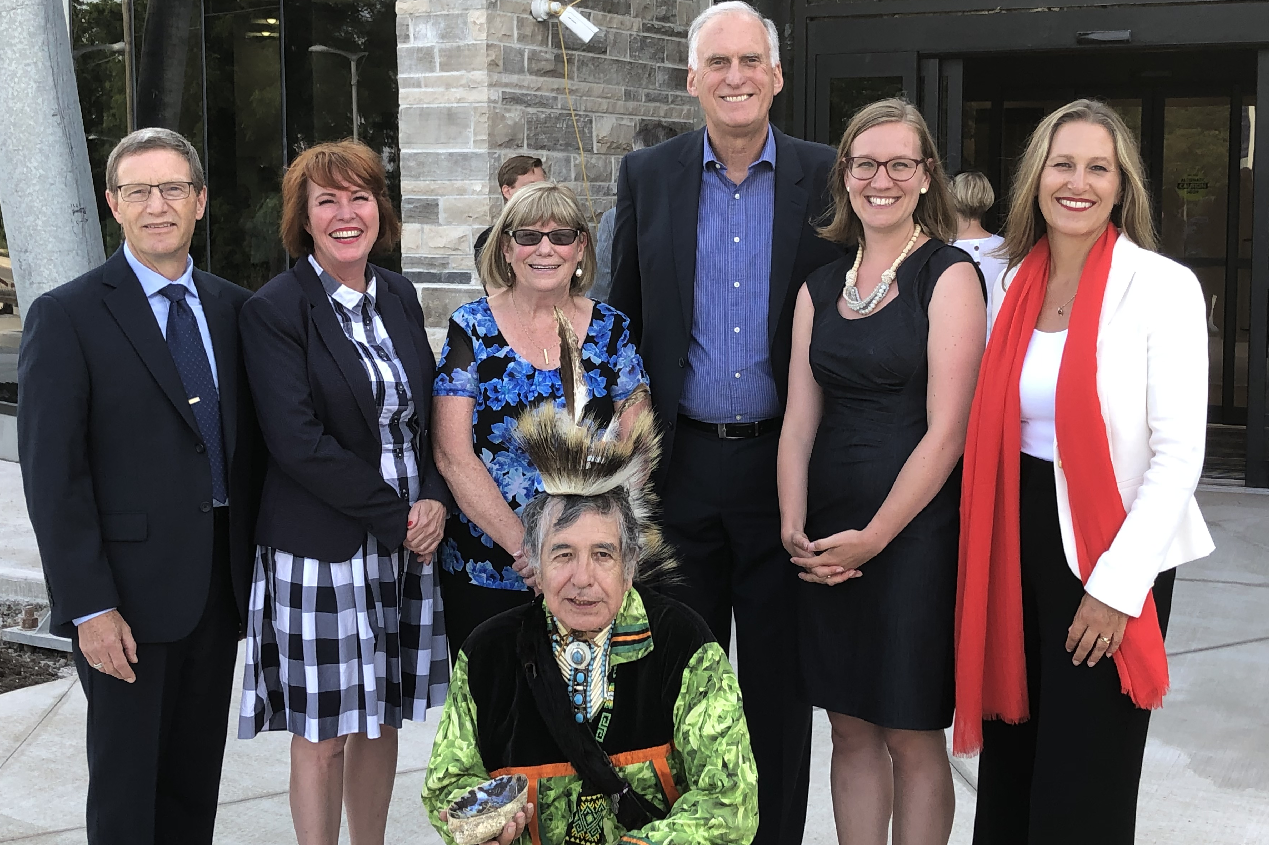 Three levels of government, project funders and donors were given a preview of the transformed Joseph Brant Museum. Back row, L – R: Larry Waldron, Chair Joseph Brant Museum Board; Burlington MPP Jane McKenna; Museums of Burlington Executive Director, Barb Teatero; John Doyle, Chair of the Burlington Museums Foundation; The Honourable Karina Gould, MP for Burlington and Minister of Democratic Institutions; City of Burlington Mayor Marianne Meed Ward. Front row: Elder Garry Sault of the Mississaugas of the Credit First Nation

|
|


























































































